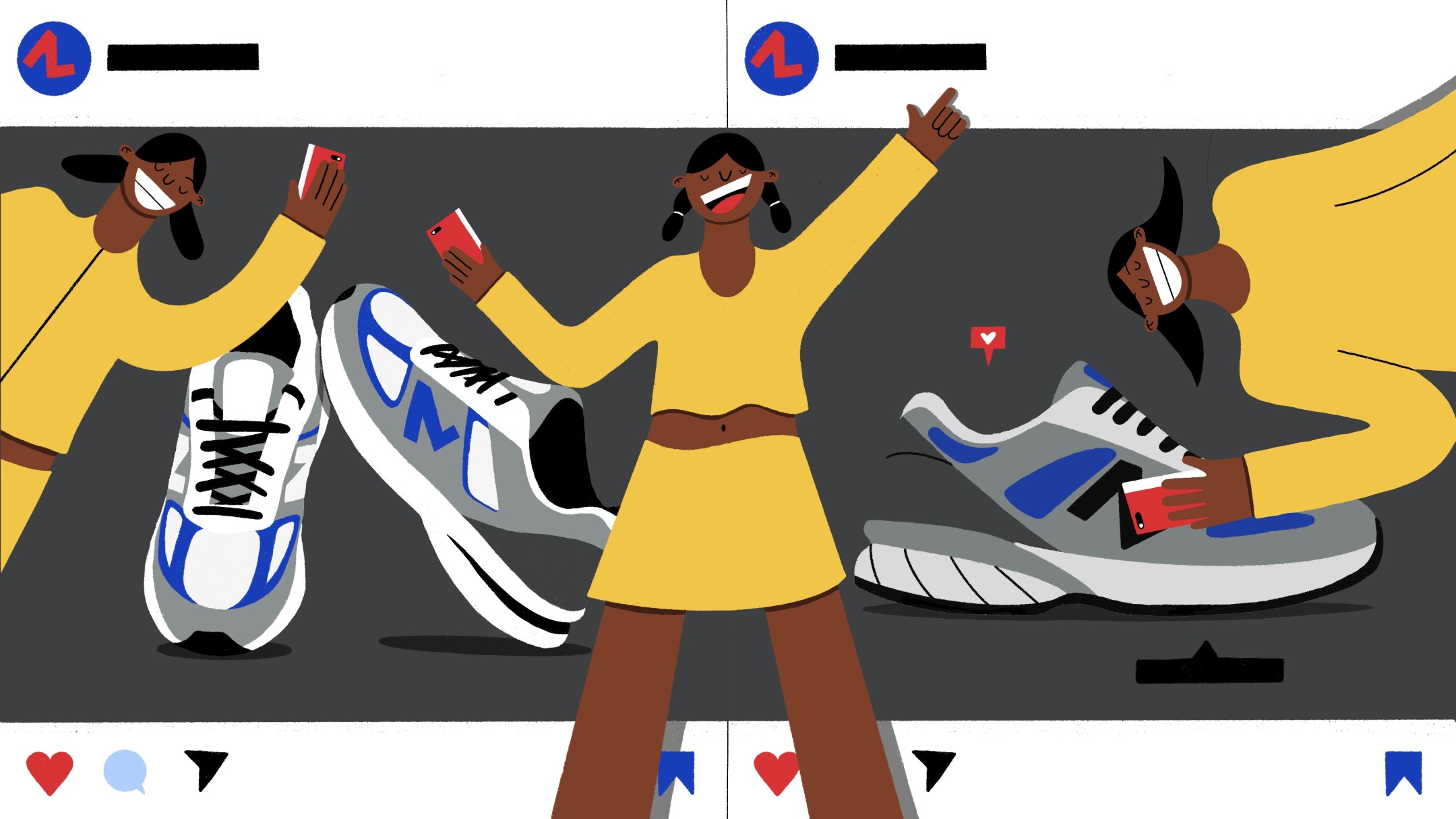Illustration by Diego Blanco
Influencer marketing is expected to generate$13.8 billion in 2021, with67% of brandsusing Instagram for this type of marketing.
Instagram has overone billion monthly active users, which makes it a leading choice among businesses when it comes toinfluencer marketing. Add to this the fact that influencer marketing generates an average return on investment (ROI) of$5.78for every dollar spent and it becomes easy to see why so many ecommerce brands are putting it to work.
If you’re still sitting on the sidelines and feeling unsure of how to approach Instagram influencer marketing for your ecommerce brand, you’re in the right place.
In this post, we’ll dive deep into how ecommerce brands can take advantage of influencer marketing on Instagram.
We’ll cover:
- Why brands invest in Instagram influencer marketing
- Who Instagram influencer marketing is for and who it is not for
- How much Instagram influencer campaigns cost
- The current state of Instagram influencer marketing
- How to run an Instagram influencer marketing campaign
- Instagram influencer marketing examples in ecommerce
Why do brands invest in Instagram influencer marketing?
Brands invest in Instagram influencer marketing because itworks.Datashows that, on average, businesses generate $6.50 in revenue for each $1 spent on influencer marketing via Instagram.
Take the example ofDaniel Wellington, a luxury watch and jewelry brand that grew to over$180 millionin just under five years—all via Instagram influencer marketing.
It makes sense:Instagram influencersare modern celebrities. As a result of years of nurturing their audiences, these influencers have built large followings within their niches. These followers then trust the influencers’ recommendations when it comes to products, which then leads to sales.
Influencer marketing on Instagram, then, is a strategy brands can invest in to promote their products by partnering with Instagram influencers who align with their audiences and goals.
What are the business benefits of Instagram influencer marketing?
There are quite a few benefits ecommerce brands can expect to achieve with Instagram influencer marketing:
- Cost-effectiveness.In the past, brands often allocated a huge chunk of their marketing budget to just one celebrity endorsement. But with the rise of Instagram influencers (and especially micro-influencers), brands can achieve impressive results with smaller budgets.
- Scale.Withinfluencer seeding and other similar strategies, brands can reach and work with multiple influencers simultaneously to rapidly scale up marketing efforts. Brands can also often reshare content created by influencers (based on usage rights) to ease the strain of constant content creation.
- Relevance.The best-fit Instagram influencers ideally share the same audience as your brand, which makes for a highly relevant partnership. Paired with the use of hashtags and the Explore page of Instagram (which is curated by the algorithm based on user behaviors), brands can easily reach their ideal audiences..
- Higher ROI.48% of marketerssay theROI of influencer marketingis better than the ROI through other channels. (See also: Nearly 7:1 return average referenced earlier.)
Who is Instagram influencer marketing for? Who is it not for?
A solid rule of thumb is to approach Instagram influencer marketing when your product is readyandyour existing customers love it. In other words: when you have product-market fit. Without a proven product, measuring the success of your campaigns can be challenging.
“Influencer marketing isn’t direct response, although it can lead to direct sales,” says Shama Hyder, CEO & founder ofZen Media. “You have to play the long game. The more you invest in your brand, the more it pays dividends.”
Most brands with a proven product can benefit from influencer marketing, but the efficiency varies depending on the industry.

How much do Instagram influencer campaigns cost?
The answer to this question is not a cut-and-dried one. It depends on the number of influencers you want to work with as well as the niche you choose.
The cost depends on several factors, such as:
- The number of content pieces (e.g., images, videos, stories) you want
- The duration of the campaign
- The audience size of the influencers (e.g., nano influencer, micro-influencer, mid-tier influencer, macro-influencer, or mega-influencer)
- Average engagement of the influencer
- Usage rights
- Production costs
- Industry and specialization
- Exclusivity
- Timeline
On average, you can expect to pay these ballpark ratesbased on the influencer’s follower count:
- Nano-influencers (1,000–10,000 followers): $10–$100 per post
- Micro-influencers (10,000–100,000 followers): $100–$500 per post
- Mid-tier influencers (50,000–500,000 followers): $500–$5,000 per post
- Macro-influencers (500,000–1 million followers): $5,000–$10,000 per post
- Mega-influencers (1 million followers or more): $10,000+ per post
Otherreportsindicate slightly different averages that vary by audience size and content type:

The bottom line:The larger the audience, the larger the price tag.
Current state of Instagram influencer marketing
If the benefits aren’t convincing enough for you to consider Instagram influencer marketing, here are some additional statistics that illustrate the current state of this market:
- Half of the influencersthat brands partner with are in the micro and mid categories, which shows that the most effective campaigns are run with smaller-scale influencers.
- Micro-influencers made up an average of93.9% of all brand partnershipsin 2020.
- 67% of brandsuse Instagram for influencer marketing.
- 65% of consumersfollow influencers on Instagram, making it the most popularsocial platform.
- Due to the pandemic (during the mid-two weeks of March 2020), there was a76% increasein daily likes on #ad posts on Instagram.
- 79% of marketersconsider Instagram to be essential for their influencer marketing campaigns.
- 72% of Gen Z and millenialssay that they follow at least some influencers on Instagram. What’s more, 88% of millennials and Gen Z say that authenticity of influencers is important to them.
Keep in mind that Instagram influencer marketing is ever evolving. Staying on top of trends, privacy changes, and data policies is essential.
User privacy changes from Apple and Google heightened the need for brands to work with first-party data. Every marketer should use influencer or affiliate marketing platforms powered by first-party tracking technology that enables accurate attribution. The right technology partner helps brands report accurate ROI and cultivate a trusting relationship with their influencers with accurate and on-time commission payments.”
—Raj Nijjer, CMO ofRefersion
How to run an Instagram influencer marketing campaign
Now that we know the growth opportunities and importance of Instagram influencer marketing, let’s look at how you can get started with it.
How do companies find the right Instagram influencers?
Sixty-one percent of marketersagree that it’s difficult to find the right influencers for a campaign. This is not surprising considering the number of influencers out there.
Joel Contartese, Marketing Director at Instaco, has managed over $10 million in influencer spend. He shared that the numbers around influencer marketing can be surprising:
The one thing you absolutely must know about influencer marketing is that the numbers don’t always tell the whole story. After spending millions on ‘celebrities,’ I’ve seen better results from influencers with a smaller but much more niched following than from the widely popular ones.”
Much of a campaign’s success depends on product/partner fit … which is what we’ll look at next.
How to find the right Instagram influencers to partner with
Step 1: Define your audience and goals
Brands first need to have clarity around goals before approaching influencers. Influencers should only come into the picture once there is a clearly definedpersonaidentifying target audience demographics, following size, etc.
Step 2: Identify ideal influencers
When it comes to finding the right influencers, there are three factors you need to consider:
- Relevance to your brand
- Engagement rate
- Past sponsorships
Relevance to your brand
Brand fit isthemost关键寻找影响者,如你want to partner with someone who reflects your brand values and ethos. By working with an influencer who aligns with your brand, partner content is more apt to authentically connect with the audience.
Brands should prioritize efficient, high-quality creator discovery with large opt-in creator networks. An opt-in creator network of prequalified partners is a key tool for rapidly identifying the right creators for campaign work. Brands can proactively discover influencers, searching by data points such as audience size, geography, niche, etc.”
—Blaire Kang McClure, Associate Product Marketing Manager atImpact
So, how do you determine if an influencer is relevant to your brand? Consider these methods:
- Hashtag research.Studying the top hashtags within your industry is a good way to spot and shortlist influencers in your niche.
- Competitor analysis.What kind of influencers are your competitors partnering with? See who and how your key competitors leverage Instagram influencers, and see what you can glean from that research.
- Influencer marketing platforms.If you find research tiring or you’re strapped for time, consider using an influencermarketing platform. Platforms likeHashtag Paidcan help you partner with niche influencers while removing some of the legwork around discovery.
Engagement rate
The “influence” of an influencer is often defined by how their audience engages with them. Don’t be fooled by the engagement an influencer gets on an average post—the engagement rate on sponsored posts tends to be on the lower end of the spectrum.
To establish a more accurate engagement rate, follow these steps:
- Pick three recent promotional posts as a baseline. You might need to dig deep to find branded hashtags or links, as promotional posts are not always obvious.
- Add the number of likes and comments and divide it by the follower count.
Unfortunately, this number will not give you the true “reach” of the post (which is calculated by adding the likes, comments, and saves divided by the follower count), as this data is not public. But even without the data, this approach can help you more accurately discern an influencer’s engagement averages.
Travis Hawley, VP of Business Development and Partnerships atViral Nation, explains this well:
“Some influencers can get people to like or comment easily. Some can’t. Some can get people to take social action: follow, screenshot, or repost. Some can’t. And some can actually get people to click and buy. There are different kinds of influence, different levels of engagement.”
Also keep in mind that, compared to macro-influencers,micro-influencers tend to generate better resultsfor brands. Bigger isn’t necessarily better in the influencer world.
Past sponsorships
Getting to know an influencer’s track record around past partnerships is another way to help you evaluate potential partners. Ask questions like: What kind of brands did they partner with in the past six to 12 months? Do they maintain consistency around the type of sponsors they work with?
These insights will help you find highly relevant partners that do quality work.
Step 3: Reach out
Next, it’s time to do some outreach. If your brand aligns with the influencer’s values, many will happily work with your brand—sometimes with a monetary payment, sometimes without it.
Here are three popular ways to pay an influencer:
- Free products.Also known as influencer seeding or product seeding,this method entails providing free products to influencers in exchange for a review or a post.
- Affiliate links or codes.The affiliate model is structured to pay influencers a percentage or flat fee based on the products sold via their unique tracking codes or links. In a way, influencers get commission on the sale using this approach. It’s one way to bring influencers in as true brand partners.
- Rates defined by the influencer.In this model, influencers are paid based on their predefined rates, which vary based on the size and duration of the campaign,content requirements, and production costs. An influencer may choose to charge you per post or per campaign.
There’s no perfect way to determine influencer compensation; it will depend on the size of the following, engagement rate, and several other factors. However, if you’re working with a tight budget, you can still partner with an influencer. Leverage other options likeproduct seedingand reaching out directly.
这是how Zach Benson, founder ofAssistagram, suggests going about it:
“Start with a direct Instagram message. Just let them know that you’re interested in working together. Keep your DM short, clear, and conversational. Include the relevant accounts, a direct request, and your trade.”
这是one of the messages Benson used in the past:
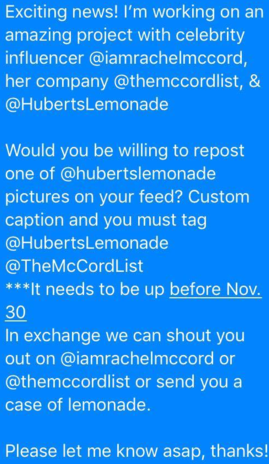
That simple DM led to a host of micro-influencer posts, like this one:

In other cases, taking a more personalized approach may be the way to win over partners.
Leverage the recent movement of the creator economy by working with influencers on a deeper level than just paying or gifting for posting their products. Consider doing a curated bundle collaboration where influencers can pick their favorites from existing products or, if the budget and time allow, consider a capsule collaboration where influencers can sell a product that they worked with you on. Brands will see greater engagement because the products are more relevant to their audience, and creators will get the chance to be a part of something bigger."
—Jason Wong, Managing Partner atWonghaus Ventures
How to estimate the cost and budget of an Instagram influencer campaign
Once you have a list of influencers you want to work with, you need to create a budget for the campaign.
One of the easiest ways to do this is simply allocating 5% to 10% of your annual marketing budget to influencer marketing. Data indicates this is a fairly common practice: 47% of marketers allocate20% of their marketing budgetto influencer marketing, while 11% of marketers dedicate more than 40% of their budget to influencer marketing.
How to estimate the cost of a single campaign
The annual influencer marketing budget you’ve defined will be spread over the year.
From there, it’s time to get more granular. If you want to estimate the cost of a single campaign, start by defining your campaign goals and key performance indicators (KPIs) to track.
Here are some examples of campaign goals and their corresponding KPIs:

Now that you know which KPIs to track, there are two ways you can budget for your campaign:
- 基于influencer’s performance
- Based on your marketing cost and budget
Let’s start with the first method, which will depend on two metrics:
- The number of followers
- The average number of likes per post
You can expect to pay between$5 to $10per 1,000 followers and$0.05 to $0.1per like based on additional factors.
So, suppose you decide to partner with an influencer who has 10,000 followers and receives 1,000 likes on average. For this example, let’s take the cost per 1,000 followers as $10 and the cost per like as $0.01.
这是你如何计算成本:
- (Number of followers) x (Cost per follower) = 10,000 x 0.01 = $100
- (Number of likes) x (Cost per like) = 2,000 x 0.1 = $200
- (Cost for followers) + (Cost for likes) = $120
找到症结了- - -金数!基于parameters of this example, you can expect to pay$120 per post per influencer.
Assuming you need one post and 10 influencers per campaign, your campaign would cost around $1,200.
Let’s move on to the next method: defining your budget based on your overall marketing budget.
Step 1: Calculate potential sales
Continuing the above example, suppose your influencer gets 100,000 unique monthly views. There are two factors to consider:
- The number of potential viewers
- The number of potential buyers
To take a conservative number of 1%, the calculation would be: 100,000 x .01 = 1,000 potential viewers. Of the 1,000 potential viewers, let’s assume 1% will convert.
So, we have 1,000 x .01 = 10 potential buyers.
Step 2: Calculate the customer's lifetime value and cost of acquisition
These are the two important metrics to track.
A customer’s lifetime value (LTV) is the total amount that an average customer would spend on your brand. And the customer cost of acquisition is the amount you spend acquiring that customer.
For example, let’s calculate the LTV as:
- Product cost = $50
- Profit margin = 30%
- Average customer lifetime = 4 months
So, we get:
Lifetime value = 50 x 0.3 = 15 x 4 months = $60
Now, we have to divide this number by three, because the ideal ratio of customer acquisition cost to lifetime value is 1:3, which means every dollar spent should make you a profit 3 times over.
Cost of acquisition = 60 / 3 = $20
Step 3: Calculate the budget
Now that we have the basic numbers in place, we can calculate the final budget. To do this, multiply the cost of acquisition with the estimated number of conversions:
20 x 10 = $200
Thus, $200 is your budget for one influencer. Multiply this with the number of influencers you want to partner with to get the cost of the entire campaign.
How to dig beyond vanity metrics to ensure ROI on Instagram influencer marketing
According to aMediakix report, marketers consider measuring the ROI of an influencer campaign to be the biggest challenge. That’s because influencer marketing can give you an illusion of success even if your goals haven’t been met. A post can get a lot of likes, but fail to meet your actual goal of conversions. This is why having clear goals from the get-go is so important.
Using free tools like Google Analytics, a link tracker, and your store dashboard on Shopify is a great place to start. For example, if your aim is lead generation, track metrics like the number of store visits and link clicks.
Other common metrics to track are:
- Click-through rate
- Cost per click
- Conversions and sales
- Engagement
Instagram influencer marketing examples in ecommerce
Next, let’s look at a few brands that have successfully put Instagram influencer marketing to work and see what we can learn from them.
Glossier
Glossieris a makeup and skincare brand that started on social media and has grown to an active and engaged Instagram following of 2.7million. It offers customizable products and focused on marketing via micro-influencers to develop a cult-like following.
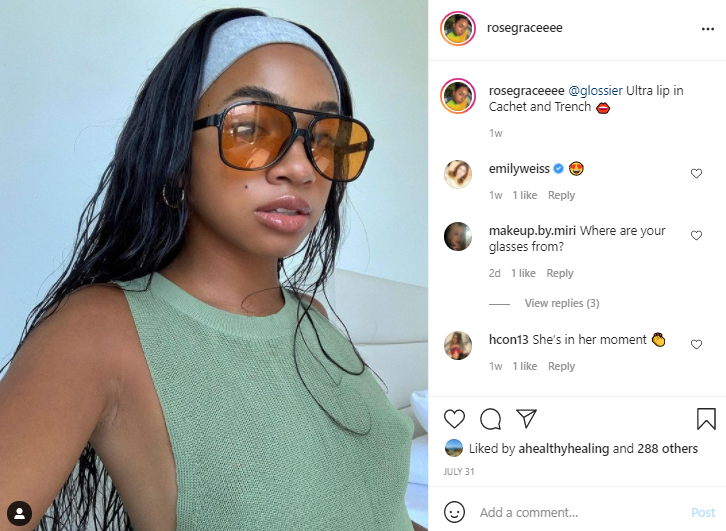
It also gives promotional codes to its influencers, who then get a commission on every product sold via that custom code. With the cross-promotion of content created by influencers, it has curated its Instagram feed with high-quality user-generated content (UGC) that attracts buyers and drives sales.

Emily Weiss, the founder of the brand, revealed that70% of its online sales and trafficcomes from peer-to-peer referrals (of which 8% is a direct result of Instagram influencer marketing).
Warby Parker
Warby Parkeris a direct-to-consumer eyeglass retailer that disrupted the eyeglass industry by offering glasses at a lower price and a try-on-at-home program.
However, influencers remain a huge part of its success. For example, it shortlisted seven influencers for one campaign based on the audience it wanted to attract. The influencers selected had audiences of different sizes (at the time of the campaign):
- Franklin Leonard: 7,800 followers
- Molly Yeh: 348,000 followers
- Edith Young: 17,000 followers
- Marley Dias: 51,700 followers
- Parker Kit Hill: 363,000 followers
- Sophia Chang: 61,900 followers
- Samantha Irby: 39,000 followers
Warby Parker had clear goals: increasing brand awareness and engagement. Using these KPIs, it was able tomeasure the campaign results, which were:
- Reach: 844,111
- Likes: 55,250
- Comments: 640
- Average engagement rate: 3.45%
Here comes the most interesting bit:Franklin Leonard, the influencer with the least number of followers, generated the highest engagement rate, at 6%.
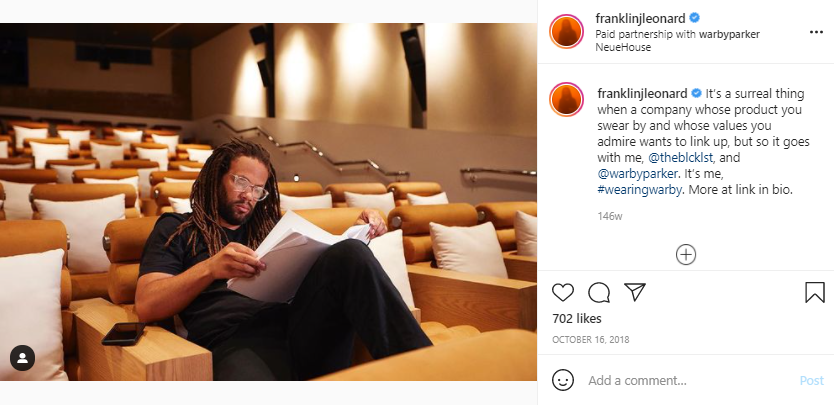
Again, the largest following doesn’t always mean the best results.
Away
Away, a luxury luggage brand, disrupted its industry by offering direct-to-consumer travel goods.
To reach its target market, it collaborated with a variety of influencers with small, medium, and large audience sizes.
The influencers integrated Away products seamlessly into their content with the help of storytelling around how the products tied into their everyday lives. Unsurprisingly, the posts with a narrative around the product received the most engagement.

As a result of collaboration with 13 influencers, the brand was able togenerate over 58,000 likeswith a 5.22% overall engagement rate, thus helping it reach its goal of increasing brand awareness.
Sozy
Clothing brandSozyis an advocate of micro-influencer marketing because it found it’s cheaper to manage compared to other types of influencer marketing.
With a budget of just about $900, it has created 35 collabs that generated 100+ photos and 35 short videos. Partnering with micro-influencers has allowed it to scale the campaign even on a strict budget.
The brand sees an increase of 30% to 40% in engagement with influencer-driven UGC over professional content produced for its website. It also has an ambassador program and sends its influencers a store gift card upon acceptance into the program that can be used to purchase items to feature within content.

Dollar Shave Club
Dollar Shave Club, a personal grooming brand, illustrates the value of choosing the right influencers. The brand generated over4.6 million impressionswith the help of only nine influencers. With over 10,300 clicks driven to its website, Dollar Shave’s influencer marketing campaign has been a huge success.
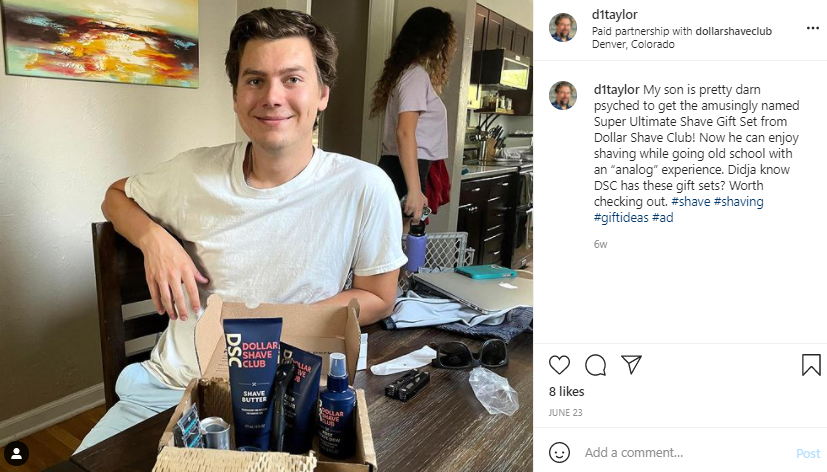
MVMT
MVMT, a watch accessories company, is an example of a brand using the influencer marketing platformGRIN.
It chose influencers with a following between 30,000 to 500,000 who aligned with its brand qualities for this campaign. Once it realized the potential of influencer partnerships, it shifted to the influencer marketing platform to grow further.
In doing so, MVMT saw 100,000 affiliate code conversions and 39,000 influencer-generated posts as a result of its continued influencer marketing efforts on Instagram.
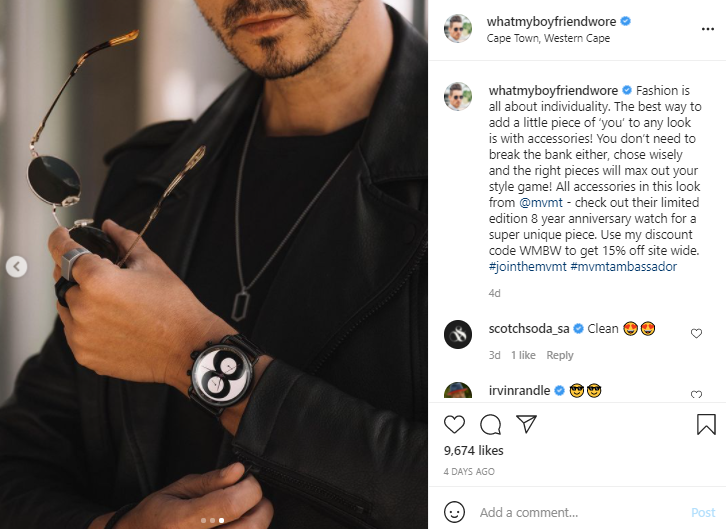
Grow your ecommerce store with influencer marketing
Instagram influencer marketing is one of the most profitable ways to market your ecommerce store.
虽然最初发现它可以是一个挑战right influencer for your brand, there’s no stopping once you get it right. Influencers look for a long-term partnership with brands, and it pays dividends to stick with the ones that bring you results.
For help with growing your ecommerce store with Instagram influencer marketing, check out ourlist of Shopify Plus Certified App Partners, where you'll find the perfect marketing solutions for your business.
Ecommerce Influencer Marketing FAQ
Does influencer marketing work for eCommerce?
Yes, influencer marketing can be an effective tool for eCommerce businesses. Influencer marketing is a great way to reach a large audience and build trust with potential customers. Influencers can help to create brand awareness, drive traffic to product pages, and increase sales. Additionally, influencers can be used to provide honest reviews of products and services, which can be very helpful in converting potential customers.
What is a good influencer marketing strategy for eCommerce?
- Develop a Clear Goal: Before deciding on an influencer marketing strategy, set a clear goal for what you want to achieve.
- Identify the Right Influencers: Identify influencers who are relevant to your eCommerce business and have a large and engaged following.
- Collaborate on Content: Work with influencers to create content that is both interesting and relevant to their audience.
- 测量结果:正的影响luencer marketing campaign to identify which strategies are working and which need to be improved.
- Adjust Your Strategy: Adjust the influencer marketing strategy as needed to ensure success.
What is eCommerce for influencers?
电子商务影响者是一个在线业务odel that allows influencers to monetize their channels and reach by selling products and services directly to their followers. This could include anything from physical products like apparel to digital products like courses. It can also include services such as consultations or one-on-one coaching. Influencers leverage their networks to promote their products and services to their followers, who can purchase them directly from their website.
What are the 3 R's of influencer marketing?
- Reach: Connecting with the right influencers who have the largest reach to your target audience and can potentially help you build your brand.
- Relationship: Establishing a meaningful relationship with influencers, and making sure that your collaboration is mutually beneficial.
- Reward: Rewarding influencers for their efforts so they are enticed to continue working with you and promoting your brand.
Read More
- Live Chat: The Most Underused Tool in Your Arsenal
- The Dark Side of Entrepreneurship with Data & Resources for Help
- How to Avoid the Hidden Cost of Black Friday, Cyber Monday Sales and Increase Customer Lifetime Value through Personalized Email
- Scaling a Global Ecommerce Business: Three Keys from $100M+ Enterprises
- Native Advertising for Ecommerce: From Content Discovery to Scaling Sales
- The Psychology of Hero Images: How to Hook Shoppers & Tell Your Story in 50 Milliseconds or Less
- Selling $3 Billion on Autopilot: Less Effort, More Growth via Ecommerce Automation
- Black Friday Facebook Ads Guide from $6.8M in Ecommerce Holiday Spend
- Multi-Channel Order Management for Multi-Million Dollar Growth
- B2B Ecommerce Features for Acquiring, Selling & Retaining Customers
